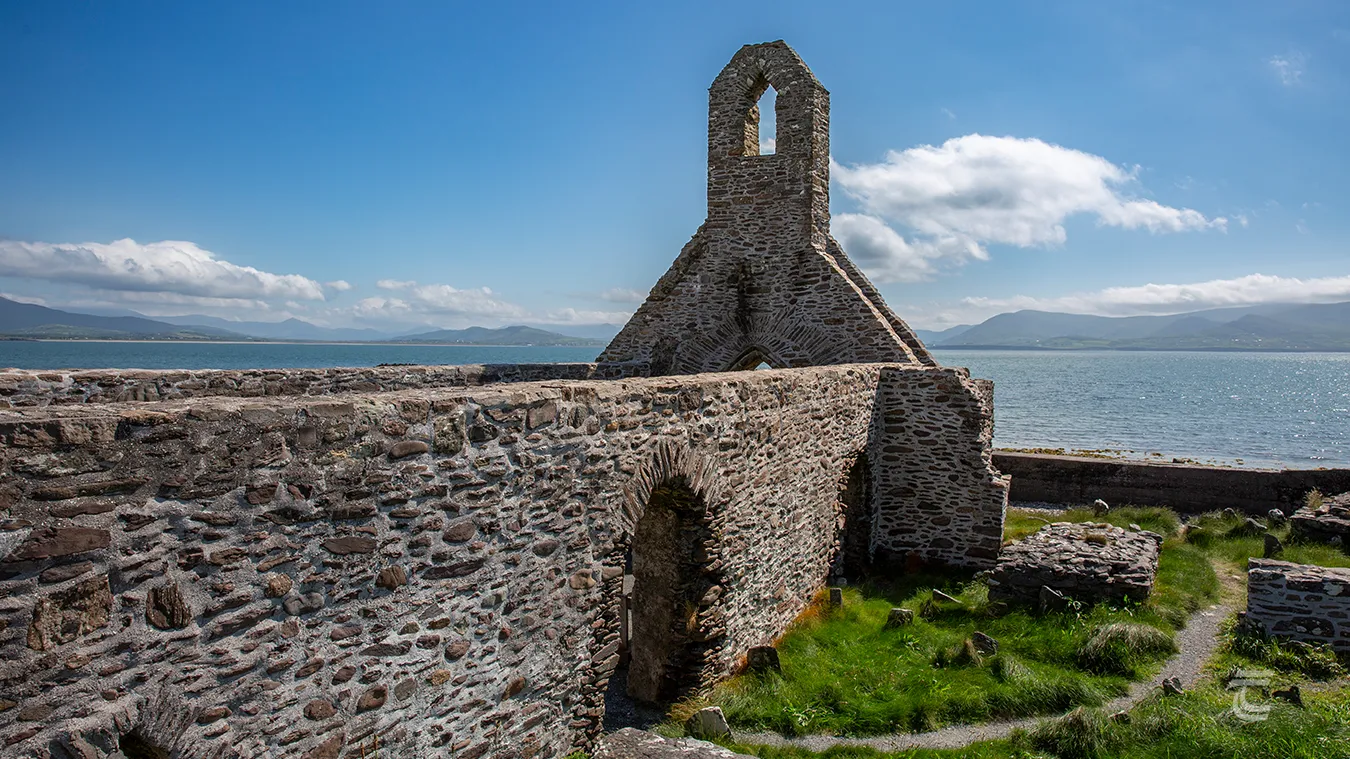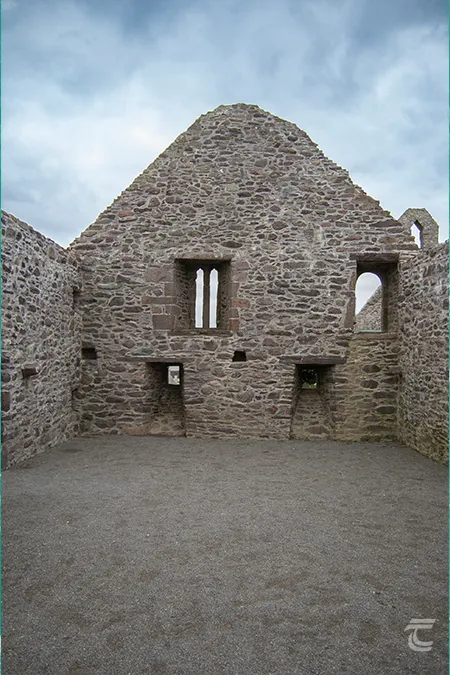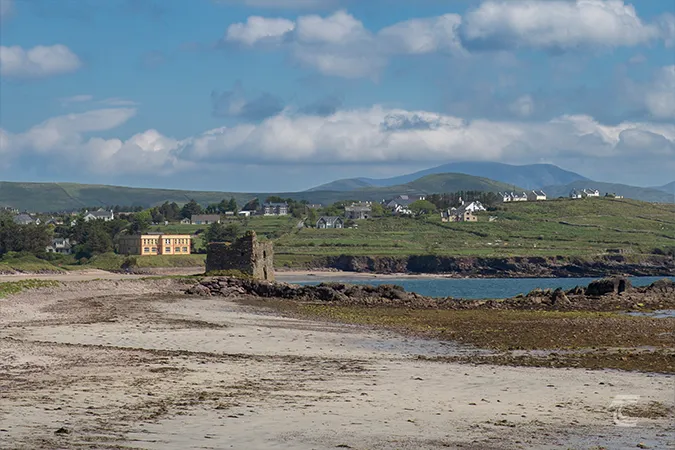Ballinskelligs Abbey
Ballinskelligs Abbey, or more correctly, the Priory of the Arroasian Canons of the Order of St Augustine, is situated on the western shore of Ballinskelligs Bay. It was founded in around c.1210. According to Giraldus Cambrensis, the island monastery of Skellig Michael appears to have transferred to this location before the mid-11th century due to the hazardous conditions on the rock. The name of the townland reflects the relocation of the monks, as Ballinskelligs derives from the Irish ‘Baile an Scelig’, meaning ‘place of the Skellig’.
The priory here at Ballinskelligs was founded by Augustinian Canons from Ratoo. The priory part of a network that included a foundation on Innisfallen Island. Together with Skellig Michael, the three sites all share a common connection with St Fíonán. With an association with such a key early saint, the Augstinian Canons benefited from pilgrimage, providing a lucrative source of income for centuries.
Ballinskelligs Priory was dissolved during the reign of Queen Elizabeth I, but it is believed it continued in use up until around 1578, when the lands of the priory were granted to Gyles Clinsher, before passing to John Blake in 1585. It then became the possession of the wealthy Richard Harding of Bristol, and later to the Sigerson family in 1615. According to an account from 1902, Richard Sigerson was due to marry Harding’s daughter. As he arrived at the Harding family home in Bristol to be married, he met her funeral party leaving the house. However, the father treated him as if she had lived and married, and gave him the manor of Ballinskelligs, with the abbey and lands attached to it.
For practical information about visiting this site Click Here
Ballinskelligs Abbey, or more correctly, the Priory of the Arroasian Canons of the Order of St Augustine, is situated on the western shore of Ballinskelligs Bay. It was founded in around c.1210. According to Giraldus Cambrensis, the island monastery of Skellig Michael appears to have transferred to this location before the mid-11th century due to the hazardous conditions on the rock. The name of the townland reflects the relocation of the monks, as Ballinskelligs derives from the Irish ‘Baile an Scelig’, meaning ‘place of the Skellig’.
The priory here at Ballinskelligs was founded by Augustinian Canons from Ratoo. The priory part of a network that included a foundation on Innisfallen Island. Together with Skellig Michael, the three sites all share a common connection with St Fíonán. With an association with such a key early saint, the Augstinian Canons benefited from pilgrimage, providing a lucrative source of income for centuries.
Ballinskelligs Priory was dissolved during the reign of Queen Elizabeth I, but it is believed it continued in use up until around 1578, when the lands of the priory were granted to Gyles Clinsher, before passing to John Blake in 1585. It then became the possession of the wealthy Richard Harding of Bristol, and later to the Sigerson family in 1615. According to an account from 1902, Richard Sigerson was due to marry Harding’s daughter. As he arrived at the Harding family home in Bristol to be married, he met her funeral party leaving the house. However, the father treated him as if she had lived and married, and gave him the manor of Ballinskelligs, with the abbey and lands attached to it.
For practical information about visiting this site Click Here

The remains of the chancel at Ballinskelligs Abbey • Kerry
The Ruins of Ballinskelligs Abbey

A view through the medieval window • Ballinskelligs Abbey
With its position right alongside the coast, time and tide have worn away at the buildings, destroying a number of structures over the decades as well as a portion of the graveyard. Overall the remains of Ballinskelligs Abbey are in relatively poor condition, although there has been conservation work carried out, along with the construction of a sea-wall, to protect what is left of the ruins. This process of erosion has long been noted, even as early as the mid-18th century:
‘By the large traces of ruined buildings which the sea is constantly demolishing, it appears that this abbey had been formerly a very large edifice’
Charles Smith, 1756: ‘The Ancient and Present State of the County of Kerry’.
The key visible features consist of the church with its rectangular nave and the north-western portion of the chancel, with a small bellcote on top. A structure known as the ‘Prior’s House’ is attached at an angle to the nave of the church, and there is the fragmentary remains of the cloister and a hall type building that may have served as the refectory. Inside the Prior’s House you can see other architectural fragments from the site, that have been dislodged from their original positions by time and tide. These fragments include parts of an ogee headed window, and arched sections from a doorway.
Archaeologists have also identified the ephemeral and fragmentary foundational remains of a number of buildings in a field just to the northwest of the priory. This may have been a small settlement cluster that grew around a small pilchard fishery that was established here by Sir William Petty in the late-17th century. A more tangible monument, Ballinskelligs Castle, can be seen down near the beach 500m or so away from the abbey. Both the castle, and priory, feature on our Ring of Kerry Itinerary, along with a number of other archaeological and historical monuments in this stunning part of Ireland.

A view through the medieval window • Ballinskelligs Abbey
Upper left: Ballinskelligs Abbey • Lower left: Ballinskelligs Castle viewed from the abbey ruin • Right: the interior
Top: Ballinskelligs Abbey • Middle: the interior • Bottom: Ballinskelligs Castle viewed from the abbey ruin
Explore more sites on the Wild Atlantic Way



